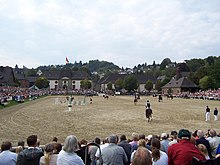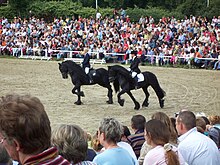Hessian State Stud Dillenburg
|
Landesbetrieb Landwirtschaft Hessen State Stud Dillenburg |
|
|---|---|
| State level | State of Hesse |
| position | State company |
| Supervisory authority | Hessian Ministry for the Environment, Climate Protection, Agriculture and Consumer Protection |
| founding | 1869 |
| Headquarters | Dillenburg |
| Authority management | come over. Stud manager Evelyn Bolan |
| Web presence | [1] |
The Hessian state stud Dillenburg is the only state stud in Hesse today . It is located in Dillenburg in the Lahn-Dill district . The state riding and driving school Dillenburg and a carriage museum are attached to the stud . The Hessian State Stud Dillenburg has been part of the Hessen State Agriculture Office since 2010 .
history
Horse breeding already existed in Dillenburg under Wilhelm the Rich . It was promoted and expanded by Moritz von Oranien in the 16th century . The Dillenburg Ramsnase breed was bred in Dillenburg . These horses were sought-after parade and carriage horses . Many horses were brought to the Netherlands for the House of Orange-Nassau .
After the Seven Years' War , the stud was housed in the buildings on Wilhelmstrasse in Dillenburg in 1772. The buildings were built from the rubble of Dillenburg Castle , which was destroyed in 1760 . They were used to accommodate the court stud of the Princes of Orange-Nassau and as homes for officials. The plans for the development of Wilhelmstrasse came from the Dillenburg building inspector Johann Friedrich Sckell .
Horse breeding was centralized when the Prussian province of Hessen-Nassau was founded after the German War . For this purpose, the state stud in Dillenburg was set up as the Hessian-Nassau state stud in 1869 . This was done with the involvement of the state studs in Kassel (founded in 1737), Korbach (founded in 1811) and Weilburg (founded in 1811). So-called stud stations have been set up to provide breeding stallions in the regions. Also known is the "stud station" in Adorf (Diemelsee), which was supplied with staff and stallions by Dillenburg from 1887 to 1987.
The state riding and driving school was established by the stud in 1930. Since then, the training of riders has been the second focus of the state stud.
When the State of Hesse was founded, the State Stud Darmstadt also existed alongside the Dillenburg State Stud. This was dissolved in 1957. Since then, the Dillenburg State Stud has been responsible for all of Hesse.
In the 1960s, the focus of horse breeding changed from cold-blooded horses for agriculture to riding and sport horses.
The archives of the Dillenburg state stud are now in the Hessian main state archive in Wiesbaden.
tasks
The main task of the state stud is the keeping of quality stallions that are used as state stallions . The stud has 17 stallions, for which there is their own rearing. The mares used in breeding come from private horse breeders. For these, the stud offers other services such as a health service and a forge for shoeing . The state stud does not breed its own horses . The Hessian State Stud Dillenburg provided the breeders with stallions and thus contributed to the development of the Hessian Warmblood breed.
The stud is an important contact point for horse breeders and equestrians . For these, the stud and the state riding and driving school offer extensive training and further education opportunities. The school offers riding exams for internationally recognized certificates. For the apprenticeship of the horse host , the stud is supervised with the inter-company training.
The Dillenburg Stallion Parade is the stud's most famous attraction. It takes place every two years, always in odd years, and attracts visitors from all over Germany. Further attractions are the annual international single horse tournaments and the dressage demonstration.
investment
The state stud is housed in buildings on Wilhelmstrasse in the city of Dillenburg. The entire area of the stud covers about ten hectares. The three late baroque main buildings (Prinzenbau, Marstall, Reithaus) form a representative street front. This was extended by another stable in 1816. Opposite the main building is the riding arena and access to the courtyard garden. More stables, the barn and the insemination station were built off the road.
The carriage museum is located in the orangery in the Dillenburg court garden. This was built in 1563 to shelter exotic plants in winter. From 1809 to 1893 it served as a Catholic church, then as a riding arena. The museum was established in 1970. Several hunting wagons , landauers and a ten-horse stagecoach and a coronation coach are exhibited in the museum.
literature
- Randolf Fügen: Highlights in Central Hesse. 1st edition. Wartenberg Verlag, Gudensberg-Gleichen 2003, ISBN 3-8313-1044-0 , p.
- Hermann-Josef Hucke (editor): Great Westerwaldführer. Verlag Westerwald-Verein eV, 3rd edition. Montabaur 1991, ISBN 3-921548-04-7
Web links
Individual evidence
- ↑ http://www.die-deutschen-landgestuete.de/landgestuet-dillenburg.html
- ↑ Archives of the Dillenburg State Stud in the Hessian Main State Archives ( page no longer available , search in web archives )
- ↑ Stallions of the Dillenburg State Stud ( page no longer available , search in web archives )
Coordinates: 50 ° 44 ′ 3.9 ″ N , 8 ° 17 ′ 18.9 ″ E




